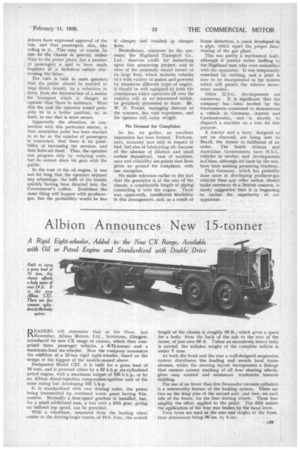Albion Announces New 15-tonner
Page 79

If you've noticed an error in this article please click here to report it so we can fix it.
A Rigid Eight-wheeler, Added to the New CX Range, Available with Oil or Petrol Engine and Standardized with Double Drive READERS will remember that at the Show, last November, Albion Motors, Ltd., Scotstoun, Glasgow, introduced its new CX range of chassis, which then comprised three passenger vehicles, a 6-71-tonner and a maximum-load six-wheeler. Now the company announces the addition of a 15-ton rigid eight-wheeler, based on the design of the biggest of the models named above.
Designated Model CX7, it is built for a gross load of 16 tons, and is powered either by a 52 b.h.p. six-cylindered petrol engine, with a maximum output of 126 b.h.p., or by an Albion direct-injection compression-ignition unit of the same rating but developing 105 b.h.p.
It is standardized with two driving axles, the power being transmitted by overhead worm gears having 8-in. centres. Normally a four-speed gearbox is installed, but, for a small additional sum, a box with a fifth gear, giving an indirect top speed, can be provided.
With a wheelbase, measured from the leading wheel centre to the driving-bogie--centre, of 18 ft. 3 ins., the overall length of the chassis is roughly 30 ft.; which gives a space for a body, from the back of the cab to the rear of the frame, of just over 24 ft. Unless an excessively heavy body is carried, the unladen weight of the complete vehicle is under 7 tons.
At both the front and the rear a well-designed suspension system distributes the loading and -avoids local frame stresses, whilst the steering layout incorporates a linkage that ensures correct tracking of all four steering wheels, gives easy control and minimizes tendencies towards skidding.
The use of no fewer than five Dewandre vacuum cylinders is a noteworthy feature of the braking system. There are two on the king pins of the second axle, and two, on each side of the frame, for the four driving wheels. These four amplify the effort applied to the pedal. The fifth assists the application of the four rear brakes by the hand lever.
Twin tyres are used at the rear and singles at the front, their dimensions being 36 ins. by 8. ins, .




























































































































































